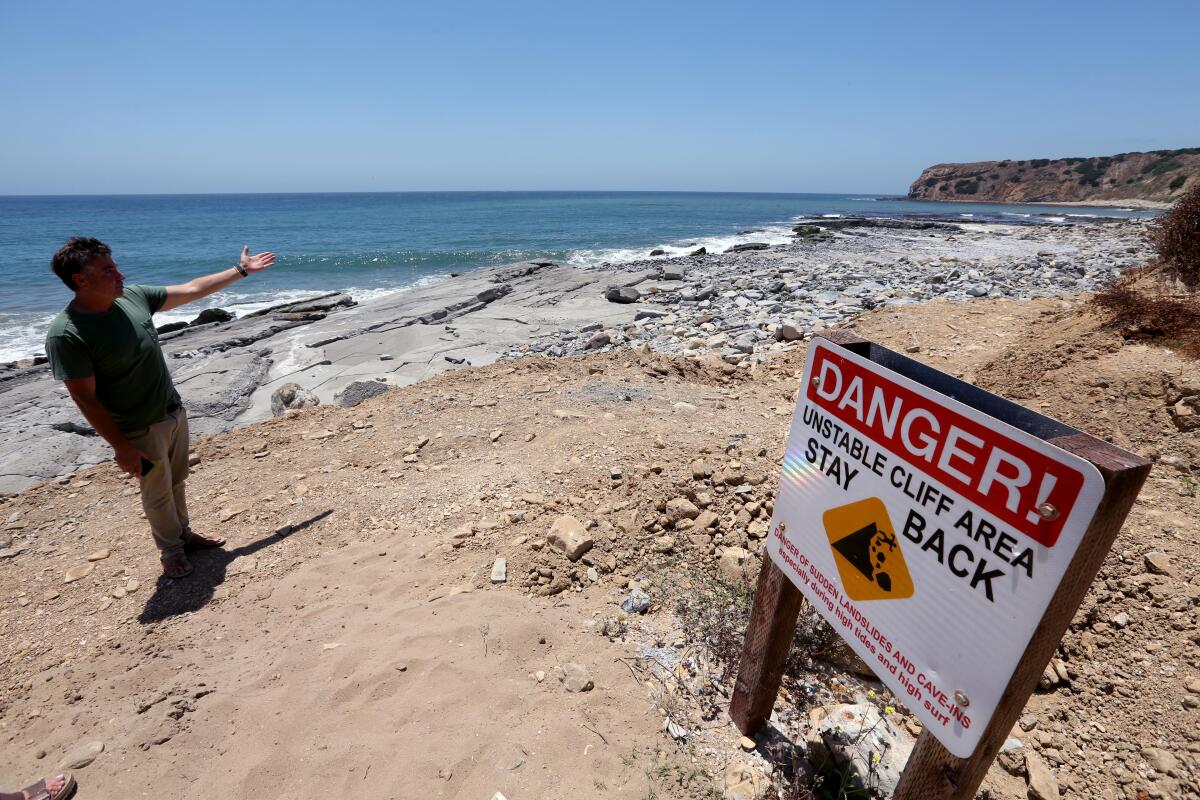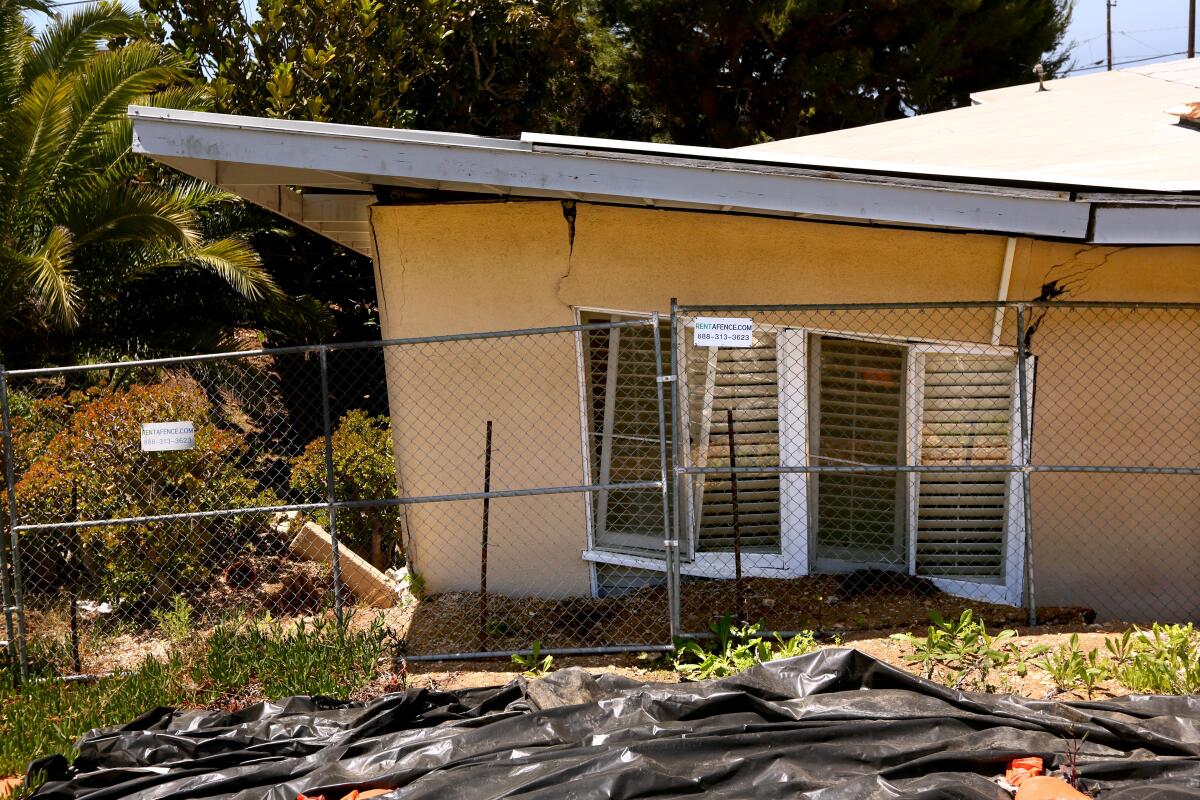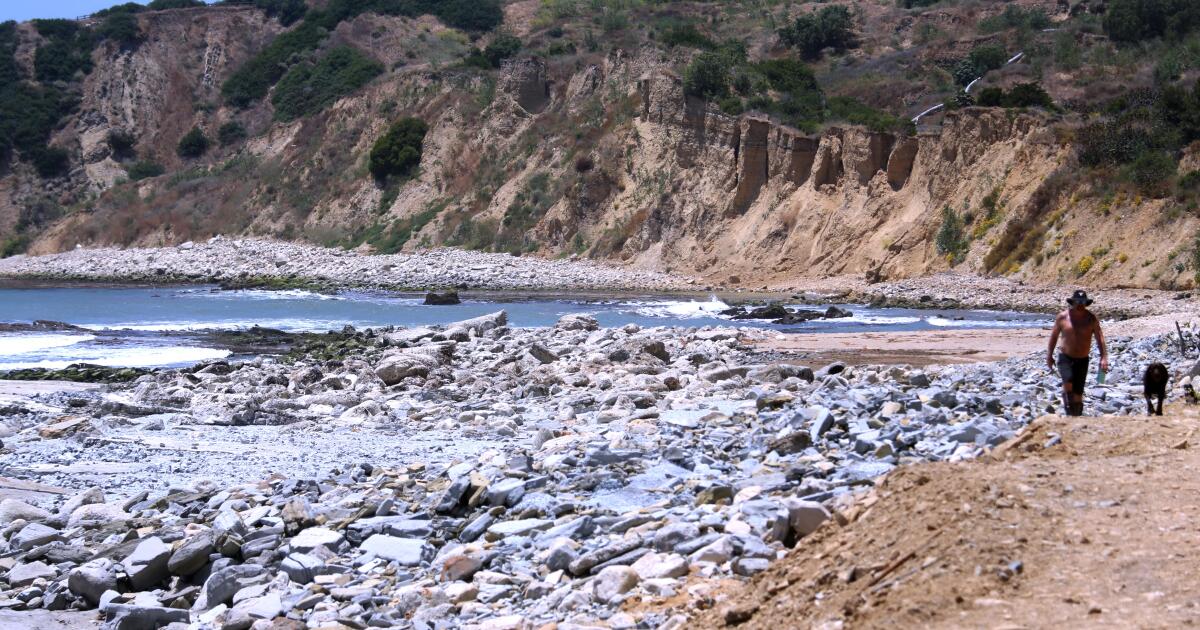Rancho Palos Verdes has a whole new coastline.
A rapidly expanding and accelerating complex of landslides on the southeastern tip of the Palos Verdes Peninsula continues to cause devastating damage to homes, roads and public structures in the area, forcing the iconic Wayfarers Chapel to at least temporarily abandon its site.
But it also brought new and unexpected changes to the waterfront: the ocean floor was pushed up, literally creating new beaches.
“That beach is brand new,” Denny Jaconi said, pointing to a stretch of rocky shoreline that didn’t exist just a few months ago. “There are three or four of us who have been surfing here our whole lives and we just can’t believe it.”
The sea where Jaconi used to ride the waves as a child, and just a few months ago, has been transformed into a beach full of large rocks, as the force of the landslide has pushed the bentonite up from beneath the sand.

“That beach is brand new,” Denny Jaconi said, pointing to a rocky shoreline that didn’t exist just a few months ago.
(Genaro Molina/Los Angeles Times)
“It’s changing every week,” he said, with new reefs appearing regularly.
Jaconi, 45, has lived in Portuguese Bend Beach Club all his life. The small gated community, located just off Palos Verdes Drive South, has the most direct access to the developing beach. The area’s large white sand beach was recently raised up into the hillside, meaning visitors coming from Seawall Road have to climb up the raised beach to get a view of the ocean.
But that’s not the end of the changes brought about by accelerating land transfers, Jaconi said.
Nearly every home in the neighborhood has sustained significant damage, with cracked walls, jammed doors, collapsing decks, and shifting foundations that get worse every day. The main road has been reduced to gravel in many places due to extensive pavement cracking. The community’s beachside tennis court was recently removed and is no longer playable due to the rippling floor.
For most people who live there, it is the first time they have seen the damage caused by this landslide complex, which is made up of at least five landslides, including the Portuguese Bend landslide, the largest and most active. The area has been plagued by landslides since the 1950s, when parts of ancient landslides were reactivated, but officials say the most recent slide, the result of two consecutive years of rainy seasons, is unlike anything on record.
“Unfortunately, things are moving faster than they’ve ever moved in history,” city geologist Mike Phipps said at a City Council meeting Tuesday night. In his latest report, he noted that landslides continue to affect new areas, with some places moving as much as 13 inches in a week. For decades, most areas saw only a few inches of movement per year.
This new rapid movement has transformed the coastline.
“The Portugal Beach Club area continues to experience significant deformation along Seawall Road and uplift/heavy lift of 4-5 feet across the beach,” Phipps said in his latest report. “This deformation appears to be continuing offshore… judging by the emergence of a large landmass at the surfline and nearshore areas at the southeast tip. [Portuguese Bend landslide].”
The new shoreline is about 250 feet out to sea after part of the ocean floor moved vertically an estimated 10 feet, “a manifestation of a larger, deeper and longer movement of the Portuguese Bend landslide,” he said.
While the findings are new for the region, geologist El Hachemi Bouari described the movement as “quite normal for a landslide.”
“Typically, landslides lose material at the top and gain material at the bottom,” says Bouari, an assistant professor of geological sciences at Nevada State University who has studied the Portuguese Bend landslide for years. “If enough material accumulates at the bottom and isn’t removed by erosion, it can cause heaves or uplift as material accumulates and causes upward deformation.”
Jaconi said it was surreal to see these geological forces at work in real time in an area he thought he knew well.
“To show the kids this whole new coastline … it’s a whole different place,” he said.
But as the disaster deepens – countless water and gas pipes have burst, at least two homes in the area have been red-tagged and families have had to make extensive repairs to protect and safe their homes – the changes along the coast have been a silver lining for Jaconi.

Continuing landslides in the Portuguese Bend area of Palos Verdes have caused extensive damage to several homes.
(Genaro Molina/Los Angeles Times)
He said the new beach allowed waves to hit rocks instead of dusty hills and made the water clearer, creating better habitat for marine life and new swimming spots.
“This is kind of our solace in the midst of this tragedy,” Jaconi said. “It’s like, ‘Oh, there’s a private beach over there and some new surf spots.'”
He doesn’t know if authorities will find a way to slow the devastating land transfer, but he remains hopeful about his family’s future here, and dreams of raising his 5-month-old son on the same (well, not quite) coast where he grew up.
“There are new tide pools here for the kids,” he said. “There are new kelp beds there, and a flock of giant pelicans that just left. … Now there’s about 50 feet of shoreline between the ocean and the mudslide.”

